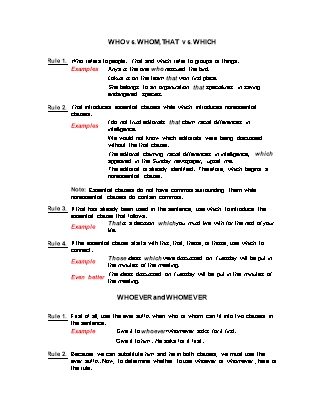Ngữ pháp Tiếng Anh Khối 6 - Relative clauses

Rule 1. Who refers to people. That and which refer to groups or things.
Examples Anya is the one who rescued the bird.
Lokua is on the team that won first place.
She belongs to an organization that specializes in saving endangered species.
Rule 2. That introduces essential clauses while which introduces nonessential clauses.
Examples I do not trust editorials that claim racial differences in intelligence.
We would not know which editorials were being discussed without the that clause.
The editorial claiming racial differences in intelligence, which appeared in the Sunday newspaper, upset me.
The editorial is already identified. Therefore, which begins a nonessential clause.
Note: Essential clauses do not have commas surrounding them while nonessential clauses do contain commas.
Rule 3. If that has already been used in the sentence, use which to introduce the essential clause that follows.
Example That is a decision which you must live with for the rest of your life.
Rule 4. If the essential clause starts with this, that, these, or those, use which to connect.
Example Those ideas which were discussed on Tuesday will be put in the minutes of the meeting.
Even better The ideas discussed on Tuesday will be put in the minutes of the meeting.
WHO vs. WHOM, THAT vs. WHICH Rule 1. Who refers to people. That and which refer to groups or things. Examples Anya is the one who rescued the bird. Lokua is on the team that won first place. She belongs to an organization that specializes in saving endangered species. Rule 2. That introduces essential clauses while which introduces nonessential clauses. Examples I do not trust editorials that claim racial differences in intelligence. We would not know which editorials were being discussed without the that clause. The editorial claiming racial differences in intelligence, which appeared in the Sunday newspaper, upset me. The editorial is already identified. Therefore, which begins a nonessential clause. Note: Essential clauses do not have commas surrounding them while nonessential clauses do contain commas. Rule 3. If that has already been used in the sentence, use which to introduce the essential clause that follows. Example That is a decision which you must live with for the rest of your life. Rule 4. If the essential clause starts with this, that, these, or those, use which to connect. Example Those ideas which were discussed on Tuesday will be put in the minutes of the meeting. Even better The ideas discussed on Tuesday will be put in the minutes of the meeting. WHOEVER and WHOMEVER Rule 1. First of all, use the ever suffix when who or whom can fit into two clauses in the sentence. Example Give it to whoever/whomever asks for it first. Give it to him. He asks for it first. Rule 2. Because we can substitute him and he in both clauses, we must use the ever suffix. Now, to determine whether to use whoever or whomever, here is the rule: him + he = whoever him + him = whomever Therefore, Give it to whoever asks for it first. Example We will hire whoever/whomever you recommend. We will hire him. You recommend him. him + him = whomever Example We will hire whoever/whomever is most qualified. We will hire him. He is most qualified. him + he = whoever WHO and WHOM Rule. Use the he/him method to decide which word is correct. he = who him = whom Examples Who/Whom wrote the letter? He wrote the letter. Therefore, who is correct. For who/whom should I vote? Should I vote for him? Therefore, whom is correct. We all know who/whom pulled that prank. This sentence contains two clauses: We all know and who/whom pulled that prank. We are interested in the second clause because it contains the who/whom. He pulled that prank. Therefore, who is correct. (Are you starting to sound like a hooting owl yet?) We want to know on who/whom the prank was pulled. This sentence contains two clauses: We want to know and the prank was pulled on who/whom. Again, we are interested in the second clause because it contains the who/whom. The prank was pulled on him. Therefore, whom is correct.
Tài liệu đính kèm:
 ngu_phap_tieng_anh_khoi_6_relative_clauses.doc
ngu_phap_tieng_anh_khoi_6_relative_clauses.doc



